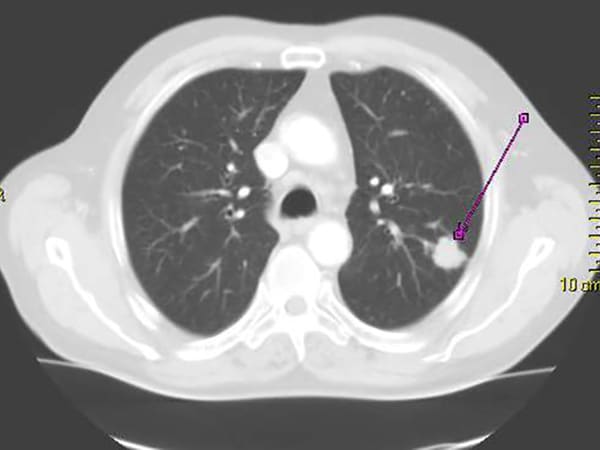From the Journals: Editors’ Picks for January
Back for the new decade is our regular staple: the monthly collection of 10 “must read” articles that have been handpicked by editors from the eight journals published by the American Association for Cancer Research (AACR). Earlier this month, the AACR announced that its ninth peer-reviewed journal, Blood Cancer Discovery, published its first article, which was highlighted in a recent blog post. Like the studies summarized below, this inaugural article is freely available.
Journal: Molecular Cancer Therapeutics
Cell motility can foster metastasis, resulting in worse outcomes for patients with cancer. Recent work indicates that the inhibition of Raf1 with the small-molecule therapeutic KBU2046 suppresses cell motility and subsequent metastasis in both in vitro and in vivo models. In the current study, the researchers evaluated if the addition of KBU2046 to pre-existing therapies enhanced disease control in mouse models of prostate cancer. They found that adding KBU2046 to docetaxel decreased metastasis compared with docetaxel alone in an orthotopic implantation model of human prostate cancer metastasis. Further, the study authors report that the effects of zoledronic acid are augmented by the addition of KBU2046 in a murine model of prostate cancer bone metastasis. The researchers conclude that multifunctional targeting paradigms that incorporate the inhibition of cell motility are worthy of further investigation. This article was highlighted in the January issue.
Journal: Clinical Cancer Research (January 15 issue)
Despite improvements in overall survival for patients with multiple myeloma, relapse is extremely common, and new treatment strategies are needed for this disease. Recently, the chemokine receptor CXCR4, which is overexpressed in the majority of cancer cells, has emerged as a potential therapeutic target for the treatment of multiple myeloma. This study reports on results from a phase Ib/II clinical trial that evaluated the CXCR4 inhibitor ulocuplumab either alone, in combination with the chemotherapeutic lenalidomide and the corticosteroid dexamethasone, or in combination with the chemotherapeutic bortezomib and dexamethasone, in patients with relapsed/refractory multiple myeloma. Among patients who received ulocuplumab plus lenalidomide and dexamethasone, a clinical benefit rate of 72.4 percent was observed, and 55.2 percent of patients in this cohort had a partial response or better. The authors conclude that CXCR4 inhibitors are a promising class of antimyeloma drugs that warrant additional evaluation in the clinical setting. This article was highlighted in the January 15 issue.
Journal: Molecular Cancer Research
Centrosome Amplification in Cancer Disrupts Autophagy and Sensitizes to Autophagy Inhibition
Centrosomes are a key component of the cellular microtubule organizing center, and centrosome amplification – an aberration resulting in an excess of centrosomes – is a common feature in many cancer cells. Centrosome amplification disrupts microtubule organization within the cell and results in multiple cellular defects, including error-prone mitoses, and therefore represents a potential therapeutic target. By testing multiple parallel hypotheses, the researchers found that centrosome amplification impairs autophagosome trafficking to lysosomes via the microtubule network, resulting in the accumulation of autophagosomes and disruption of the autophagy pathway. Further, their results show that cells with centrosome amplification are more reliant on autophagy for survival and are more susceptible to autophagy inhibition, such as treatment with chloroquine, compared with control cells without centrosome amplification. The authors conclude that centrosome amplification could serve as a biomarker to identify patients sensitive to autophagy inhibitors. This article was highlighted in the January issue.
Journal: Clinical Cancer Research (January 1 issue)
The FOLFIRINOX regimen, a combination of 5-fluorouracil, leucovorin, irinotecan, and oxaliplatin, is an effective treatment for pancreatic cancer that carries significant toxicity, which limits its utility. In a phase I/II clinical trial, a modified FOLFIRINOX regimen termed FOLFIRABRAX, which substitutes nab-paclitaxel for oxaliplatin, was evaluated in previously untreated patients with advanced gastrointestinal cancer. The doses of irinotecan were guided by UGT1A1 genotypes. Among the 50 patients enrolled, the overall response rate was 31 percent, and this therapeutic regimen yielded lower rates of grade 3 or higher neuropathy compared with historical patients treated with FOLFIRINOX. The authors conclude that this first-ever evaluation of FOLFIRABRAX warrants randomized studies to compare its safety and efficacy with the FOLFIRINOX regimen. This article was highlighted in the January 1 issue.
Journal: Cancer Prevention Research
Previous studies showed that incidence of colorectal cancer is inversely associated with nut and seed consumption, and walnuts have been found to inhibit colorectal cancer growth in mice. Increasing evidence suggests that colorectal cancer develops due to disturbances of the gut microbiota. Here, the authors analyzed the effect of walnut consumption on the gut microbiota of mice that were induced to develop colon cancer. Mice were fed a total Western diet supplemented with differing amounts of walnuts. To induce colon cancer, mice were injected with azoxymethane (AOM). Colon tumors were quantified by staining of the colon, and gut bacteria were identified by sequencing 16S RNA isolated from fecal samples. The authors identified three enterotype-like clusters (E1, E2, and E3) of gut microbiota in this murine model. They found that the E1 enterotype was associated with AOM exposure, E2 was associated with walnut consumption, and E3 was associated with the total Western diet. E1 and E3 were both enriched with Bacteroidaceae, while E2 was enriched with Porphyromonadaceae and Lachnospiraceae. The E2 enterotype was enriched for genes associated with microbial pathogenesis, including genes that regulate cell motility, replication and repair, and amino acid metabolism. The E2 enterotype was associated with a moderately lower tumor burden. The authors conclude that walnut consumption alters the composition of the gut microbiota and propose that the reduced colorectal cancer risk associated with walnut consumption may be due to changes in the gut microbiota.
Journal: Cancer Epidemiology, Biomarkers & Prevention
Although first-degree relatives of patients with colorectal cancer have an increased risk for the disease, many are not up-to-date on colorectal cancer screening. In this study, the authors examined the impact of interventions on adherence to screening recommendations. The study included 1,043 evaluable individuals who were first-degree relatives of patients with Lynch syndrome-negative colorectal cancer. Participants were randomized to either a website-only intervention or a website plus patient navigator intervention. The website intervention involved visiting a website to complete a survey, after which a personalized screening recommendation would be provided. Those in the website plus patient navigator intervention also received follow-up phone calls from a patient navigator to discuss barriers to screening, provide advice on overcoming barriers, and assist with scheduling. After 14 months, 78.6 percent of all evaluable participants had adhered to their screening recommendation, and there were no significant differences in adherence between the two arms. However, among the participants who were recommended to undergo immediate screening, those in the website plus patient navigator intervention arm were 2.98 times more likely to have adhered to the recommendation. The authors conclude that addition of a patient navigator to a website intervention does not improve overall adherence to colorectal cancer screening by first-degree relatives, but it does increase adherence among those who need immediate screening. This article was highlighted in this issue.
Journal: Cancer Discovery
ID1 Mediates Escape from TGFβ Tumor Suppression in Pancreatic Cancer
Transforming growth factor beta (TGFβ) has both tumor-suppressive and tumor-progressive effects in cancer. In pancreatic epithelial progenitor cells, TGFβ triggers epithelial-to-mesenchymal transition (EMT), a tumor-progressive event, which then leads to apoptosis, a tumor-suppressive event. Approximately half of pancreatic ductal adenocarcinomas (PDAs) retain the function of the TGFβ pathway, somehow overcoming its tumor-suppressive function while harnessing its ability to promote invasion and immunosuppression. In this study, the authors explored the mechanism that allows PDAs to overcome TGFβ-mediated apoptosis. By examining the transcriptional network of PDA cells, they found that PDA cells harbor increased expression of the transcription factor ID1. Ectopic TGFβ treatment led to the downregulation of ID1 expression in normal cells but not in PDA cells in which the TGFβ pathway remained active. Further analysis suggested that activation of the PI3K-AKT pathway prevented TGFβ-mediated ID1 downregulation. Sustained expression of ID1 prevented TGFβ-mediated apoptosis in PDA progenitors. Together, these results suggest that PI3K-AKT activation sustains ID1 expression, which allows PDA cells to uncouple the tumor-progressive TGFβ-mediated EMT from tumor-suppressive downstream apoptosis. This article was highlighted in this issue and was featured on the cover.
Journal: Cancer Research (January 1 issue)
Suppression of LIM Kinase 1 and LIM Kinase 2 Limits Glioblastoma Invasion
Glioblastoma is an aggressive disease characterized by rapid cellular infiltration of brain tissue. The LIMK1 and LIMK2 kinases, which are involved in cell polarization, migration, and invasion, are upregulated in glioblastoma and other infiltrative cancers. In this study, the authors examined the impact of LIMK suppression on glioblastoma infiltration and tumor growth with in vitro assays and an orthotopic xenograft mouse model. Using cell culture models of glioblastoma as well as patient-derived glioblastoma tumor-initiating cells, the authors found that combined knockdown of LIMK1 and LIMK2 dramatically decreased invasive cellular motility, while knockdown of either kinase alone had minimal effects. Further analysis demonstrated that LIMK1 and LIMK2 regulated cell invasion, in part, by disrupting actin cytoskeletal architecture, polarization dynamics, and chemotaxis. In an orthotopic xenograft mouse model, tumors derived from LIMK1/2 knockdown tumor-initiating cells were smaller and had delayed growth kinetics compared to controls, and mice with these tumors had a 30 percent longer survival. Together, these results suggest that LIMK1 and LIMK2 regulate invasive motility and tumor growth in glioblastoma. The authors propose that LIMK2 and LIMK2 may be viable druggable targets for glioblastoma. This article was featured on the cover of the January 1 issue, seen here.
Journal: Cancer Immunology Research
Tryptophan catabolism in tumor cells and the resulting depletion of tryptophan in the extracellular space contribute to a strongly immunosuppressive tumor microenvironment. Two enzymes, indoleamine 2,3-dioxygenase (IDO1) and tryptophan 2,3-dioxygenase (TDO), can catalyze tryptophan. IDO1 is known to be frequently expressed in tumors and has been studied as a potential therapeutic target; however, TDO expression in tumors is not well characterized. In this study, the authors developed TDO-specific monoclonal antibodies, which they used to demonstrate that TDO is expressed in the majority of human cancers. They found that TDO was expressed by most tumor cells in all of the hepatocellular carcinoma samples they examined and in some of the glioblastoma and kidney carcinomas examined. All of the cancers they tested contained TDO-expressing pericytes, which were found in morphologically abnormal tumor vessels and in areas characterized by angiogenesis. TDO-expressing pericytes were also detected in inflammatory pulmonary lesions with granulation tissue and in chorionic villi, both of which feature angiogenesis. The authors propose that TDO may be a relevant therapeutic target for hepatocellular carcinoma and suggest that TDO may serve a proangiogenic function in other cancer types. A companion study published in this issue demonstrates that inhibition of TDO enhances the efficacy of immune checkpoint inhibitors in mice. Both articles were featured on the cover of this issue.
Journal: Cancer Research (January 15 issue)
Twist1-Induced Epithelial Dissemination Requires Prkd1 Signaling
The molecular basis of cancer-cell dissemination, a fundamental prerequisite for metastasis, has yet to be fully elucidated, and identifying targetable effectors of this process is an area of active investigation. Because the expression of the transcription factor Twist1 can trigger dissemination, the authors of this study developed an inducible Twist1 3D mammary epithelial culture as a model system. They found that the serine/threonine protein kinase Prkd1 is a direct transcriptional target of Twist1 that is not expressed in normal mammary epithelium. Analysis of samples from patients with breast cancer revealed that the expression of Twist1 and Prkd1 was associated with metastatic recurrence. When the authors knocked down Prkd1 in a mouse model of basal breast cancer, they found that both primary tumor invasion and distant metastasis were inhibited. The authors conclude that the evaluation of Prkd1 inhibitors in vivo will be necessary to gauge their potential as a viable anticancer strategy. This article was highlighted and was featured on the cover of the January 15 issue.



